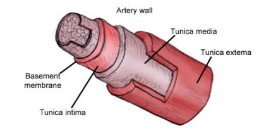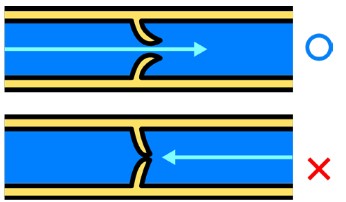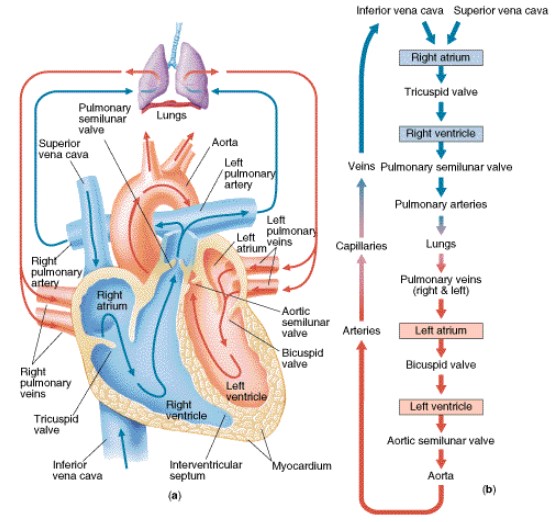Topic 6: Human physiology
6.2 The blood system
Blood Vessel
⇒ Arteries:
- Take blood away from the heart to tissues around the body
- Because large volumes of blood are flowing directly out of the heart, arteries must be able to withstand the high pressure and high blood volume created when the ventricles contract.
- Very thick wall of smooth muscle tissue surrounding arteries makes them strong and elastic in nature with a narrow lumen (area where the blood flows).
- Elastic fibres store energy when they are stretched by the flow of blood. As they recoil the blood is further propelled through the artery.
- The thick smooth muscle layer in the arteries can be used to help regulate blood pressure by changing the diameter of the arteries.

- Tunica externa – outer layer made from connective tissue and elastic fibre
- Tunica media – thick layer containing smooth muscle
- Tunica intima – endothelium layer that lines the inside of the artery
- When the ventricles of the heart contract (systole), the blood leaves the heart through the arteries at a very high pressure
- The blood pushes the walls of the arteries outwards, thus increasing the diameter of the lumen and creating potential energy within the elastic walls of the artery
- As the blood passes after the heart has contracted, the pressure drops and the stretched elastic walls snap back, squeezing the blood in the lumen to conserve energy and preventing the pressure from becoming too low inside the arteries
- However, since this pressure still relatively high, blood flow in the arteries is fairly consistent and steady, even though the heart pumps in pulsating manner
⇒ Capillaries:
- Capillaries have a very narrow diameter (one cell thick 10 μm) with thin surrounding endothelium cells to allow the shortest distance for \(O_2\) to diffuse into the blood from the alveoli in the lungs and from the blood into the body tissues. \(CO_2\) also can easily diffuse out of the blood into the alveoli in the lungs and from the tissue into the blood after respiration.
- The walls have pores, making them very permeable allowing plasma to leak out and form tissue fluid, which contains oxygen, glucose and all other substances contained in the blood plasma, except proteins (too large to fit through the pores in the capillary wall)
- Highly branched networks of capillaries increase the surface area, maximizing the amount of nutrients and gases that can move in and out of the capillaries.
- Because they are highly branched, the blood slows down to allow efficient transfer of \(O_2\) and \(CO_2\) into and out of the capillaries.
- Capillaries have small lumen and low pressured blood
⇒ Veins:
- Transport blood back to the heart from the capillary beds in tissues.
- Very low blood pressure and therefore the walls can be thin. Blood is pushed back to the heart through the contraction of skeletal muscles. As the muscles contract, the veins are squeezed, pushing the blood back towards the heart
- Large lumen allows large amounts of blood to slowly return to the heart because the blood has to slow down as it passes through the capillary beds.
- Since the blood pressure in the veins is quite low because the blood slows down considerably when it reaches the capillary bed and there is not another pump like the heart to speed up the flow and increase the pressure, veins have a series of valves to prevent backflow

Comparison table between different types of blood vessels

Blood Circulation
- Humans and other mammals have a two different circulations of blood (blood is pumped twice).
- One circulation (systemic circulation) goes from the left ventricle to the rest of the body and back to the right atrium.
- The second circulation (pulmonary circulation) goes from the right ventricle to the lungs and returns to the left atrium of the heart
Pulmonary Circulation
- Blood flows from the vena cava the right atrium into the right ventricle through the tricuspid valve. The right atrium contracts right when the ventricle is almost full in order to push the rest of the blood into the ventricle.
- The right ventricle contracts sending the blood out of the ventricle past pulmonary valve, through the pulmonary arteries to the lungs..
- The blood flows through capillaries obtaining oxygen from the lungs and returning to the heart by the pulmonary veins; which empty into the left atrium.
- This blood is actually returning to the heart from the lungs at the same time as the blood that returns to the right atrium from the rest of the body.
Systemic Circulation
- The blood then flows into the left ventricle through bicuspid valve.
- The left ventricle contracts, sending the blood through aortic valve and out through the biggest artery in the body called the aorta.
- The oxygenated blood flows to all the tissues and organs in the body to be used in aerobic respiration.
- Blood then flows from the capillaries to the numerous venules and then through the different veins in the body
- These will all eventually dump the blood into the inferior and superior vena cava
- Blood returns to the right atrium of the heart flowing from vena cava
- Note: Both ventricles contract at the same time sending blood to the lungs and the other parts of the body
Heart structure

Control of heart beat
- The heart beat is initiated by a group of specialized muscle cells in the right atrium called the sino-atrial(SA) node.
- The sino-atrial node acts as a pacemaker, sending a wave of excitations, leading to contractions of muscles.
- Atrial-ventricle (AV) node: excitation of SA node is conducted by AV node, then sending to the ventricle muscles.
- Myocardium is the muscle cells in the heart, and is thicker in left ventricle (need more pressure)
- Heart muscles have 30%-40% of mitochondria
- The rate of the pacemaker can be affected by nerves connected to the medulla region of the brain.
- Low blood pressure, high levels of \(CO_2\) (low pH) and low levels of oxygen, stimulate the heart to increase its rate and therefore deliver more oxygen to the tissues and remove more carbon dioxide
- Cardiac nerves which are part of the sympathetic nervous system that signal heart rate to increase.
- The medulla of the brain controls most of the autonomic functions of the body such as breathing, heart rate and blood pressure.
- Cardiac nerves also cause the release of epinephrine (adrenalin) from the adrenal glands during strenuous physical activity or times of high levels of stress. This is also known as the fight or flight response
